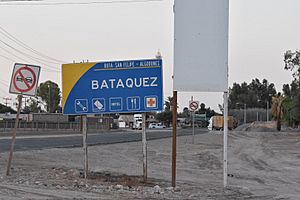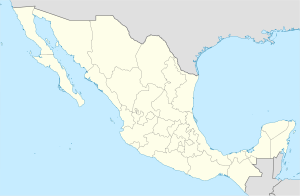Batáquez facts for kids
Quick facts for kids
Batáquez
Estación Batáquez / Ejido Monterrey
|
|
|---|---|
|
Town
|
|
 |
|
| Country | |
| State | Baja California |
| Municipality | Mexicali |
| Elevation | 20 m (70 ft) |
| Population
(2010)
|
|
| • Total | 1,121 |
| Time zone | UTC−8 (CST) |
Batáquez, also known as Estación Batáquez or Ejido Monterrey, is a small town in Mexico. It is located in the Valley of Mexicali, within the Mexicali area of Baja California.
According to information from INEGI (Mexico's statistics agency), Batáquez is found at specific map coordinates. In 2010, about 1,121 people lived there. Even though it is a small town, Batáquez is important locally. It serves as the main town for its municipal delegation, which is like a local district.
The name "Batáquez Station" comes from a railway station. This station was in the town from its early days until the middle of the 20th century. The railway was called the Inter-California Railway, but people often called it the "pachuco train." Over time, the town of Ejido Monterrey grew right next to this station.
Batáquez is mainly connected by two important roads. Federal Highway No. 2 crosses through the town from east to west. State Highway No. 3 also meets Federal Highway No. 2 here. State Highway No. 3 goes south and connects Batáquez with Guadalupe Victoria. Guadalupe Victoria is the biggest and most important town in the Mexicali valley area.
History of Batáquez
The Railway's Arrival
In 1904, a company called Southern Pacific got permission to build a railway line. This line would go south of the border to connect San Diego with Yuma. The railway entered Mexico near Mexicali. Then, it went east towards Los Algodones. From there, it crossed back into the United States, heading to Yuma.
This railway was officially known as the Inter-California Railway. However, many people called it "El Chinero." This nickname came from the fact that most of its passengers in the valley were Chinese workers. They traveled from one farm to another for agricultural jobs. At that time, more Chinese people lived in the rural areas than Mexicans.
Towns Along the Tracks
As the railway was built, new towns started to appear around the train stations. These towns included Pascualitos, Sesbania, Cucapá, Pólvora, Hechicera, Batáquez, Paredones, and Cuervos. Each of these places grew because of the railway.
| Historical Demography | |
|---|---|
| Censos Years |
Population |
|
|
|
| 1921 | 197 |
| 1930 | 377 |
| 1940 | 146 |
| 1950 | 340 |
| 1960 | 583 |
| 1970 | 625 |
| 1980 | 852 |
| 1990 | 983 |
| 1995 | 1,076 |
| 2000 | 1,258 |
| 2005 | 1,127 |
| 2010 | 1,121 |
See also
- In Spanish: Batáquez para niños


